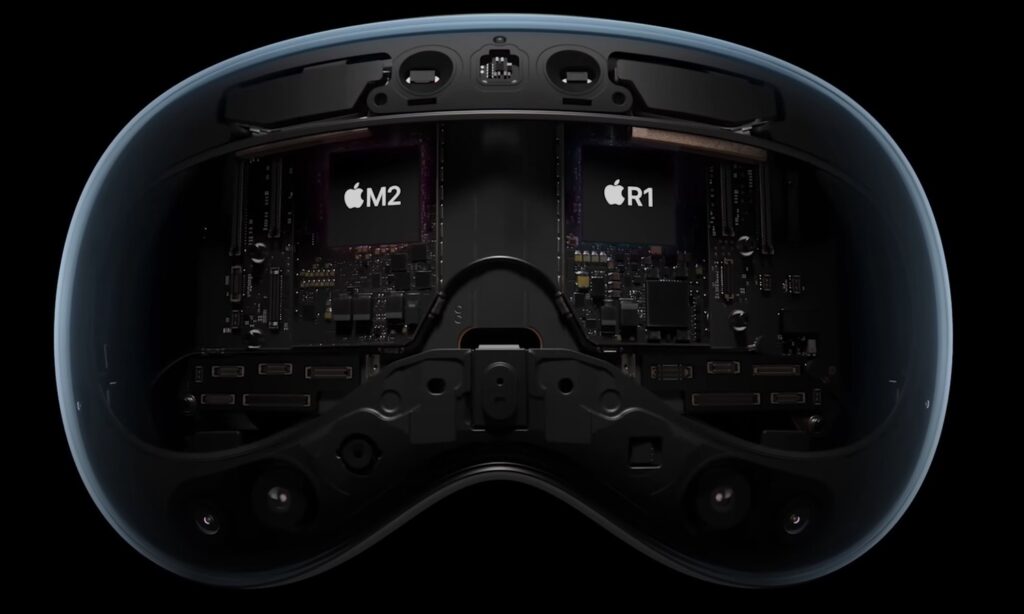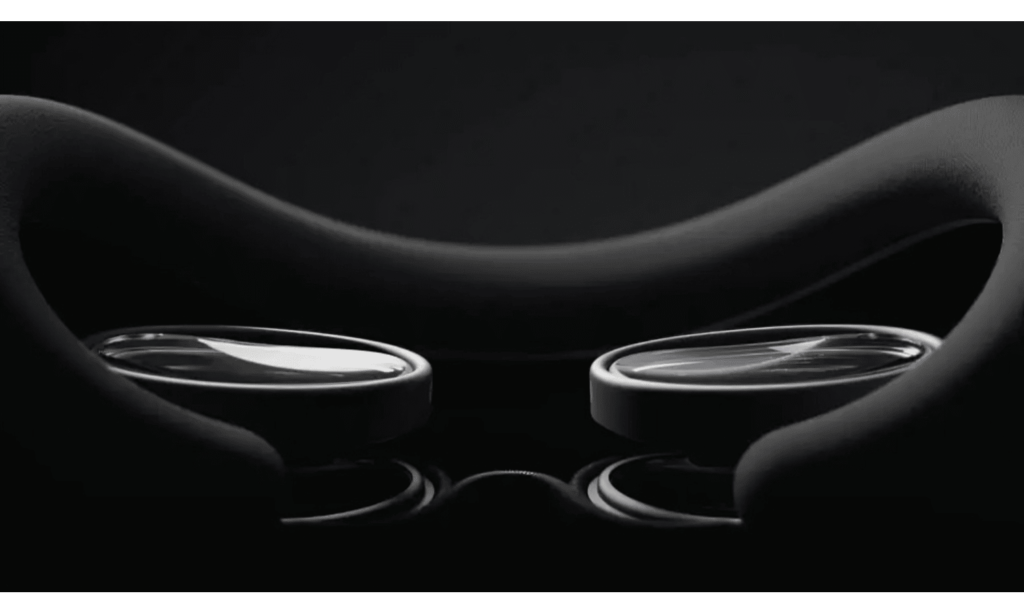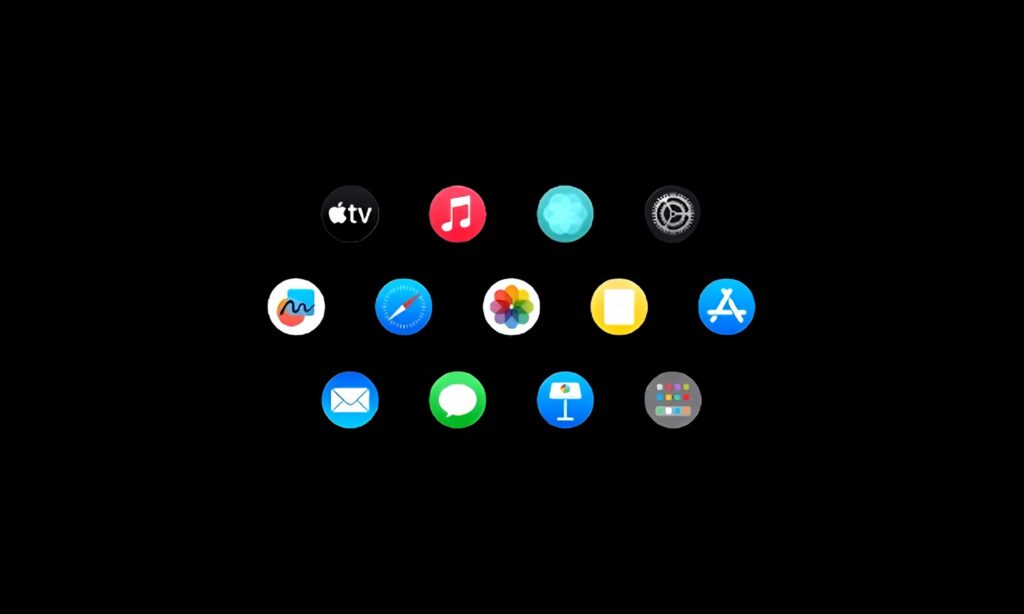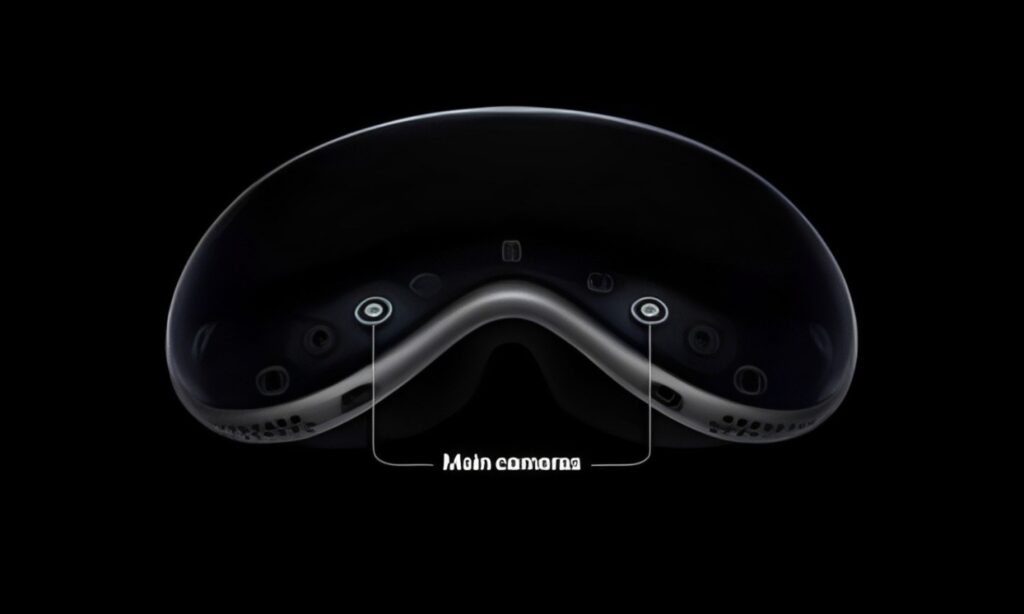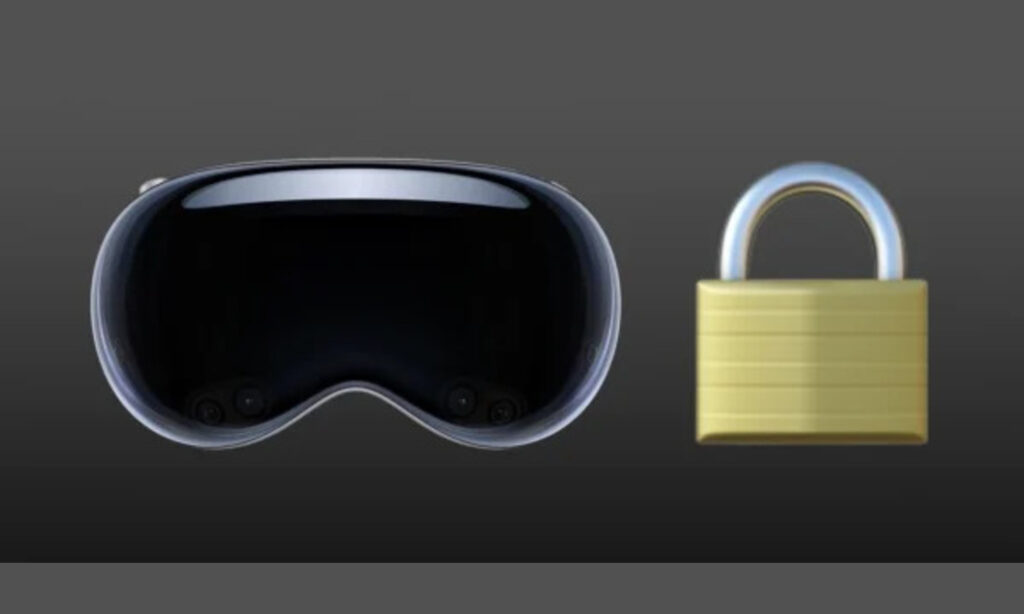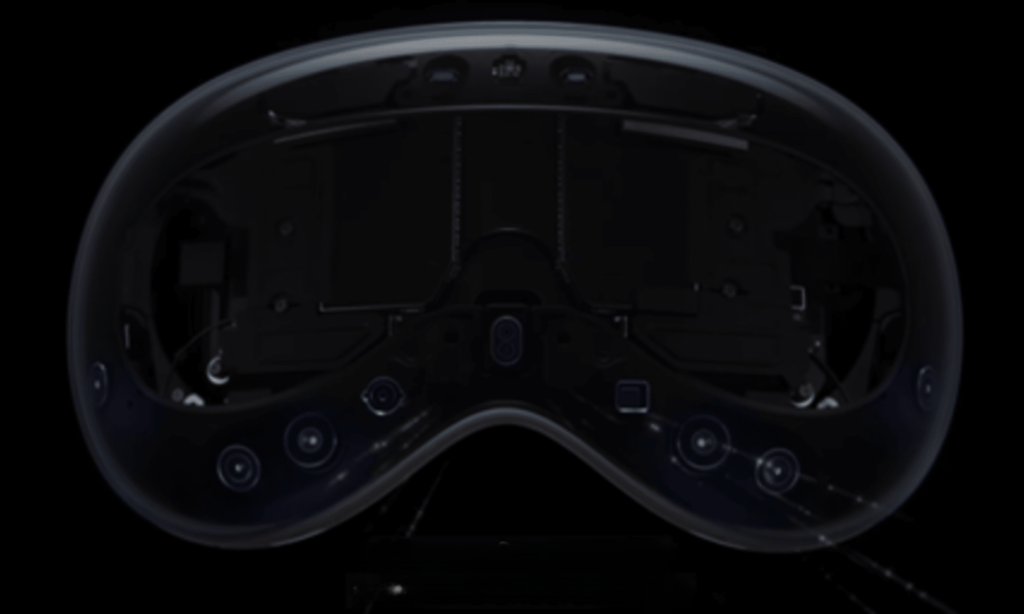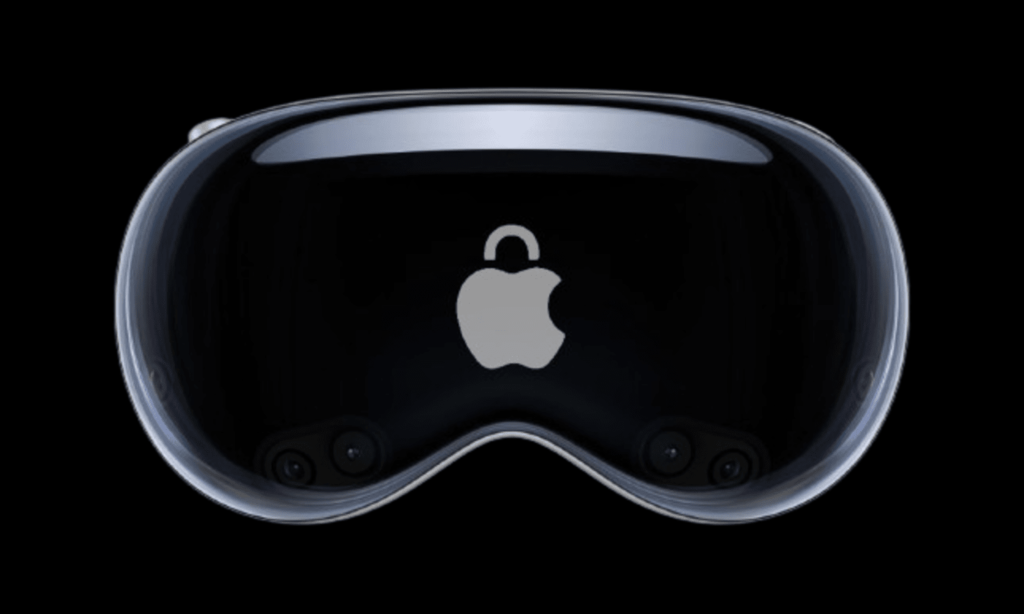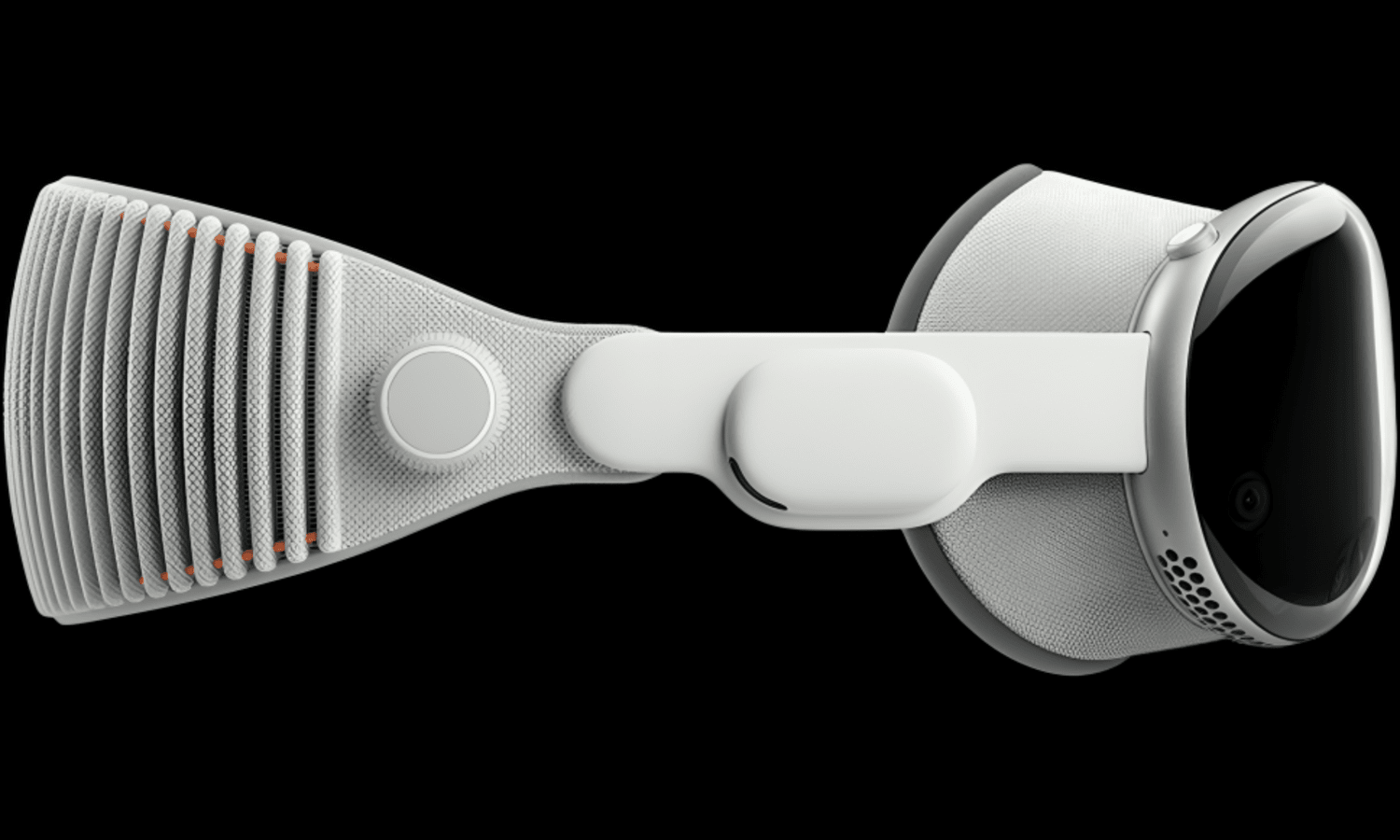Apple Vision Pro: A Deep Dive into the Specifics of a Spatial Computing Pioneer:
The Apple Vision Pro is not your typical pair of glasses. It’s a glimpse into the future of computing when the digital and physical merge effortlessly. This mixed-reality headgear, slated to be released in late 2023, combines cutting-edge technology with Apple’s signature design language. But what makes the Vision Pro tick? Let’s go into the intricacies and investigate the technical miracle behind the Apple Vision Pro’s capabilities.
Display: A feast for the eyes.
The Vision Pro experience revolves around its beautiful display system. Apple uses two micro-OLED screens, each with a resolution of 3660 x 3200 pixels. This corresponds to a stunning total of 23 million pixels, resulting in an extremely clear and detailed image. Micro-OLED technology is well-known for its high contrast ratios, deep blacks, and brilliant colors, making it an ideal choice for a fully immersive experience.
To improve user comfort, the displays have a variable refresh rate of 90Hz, 96Hz, and 100Hz. This enables the Vision Pro to react to the content being seen, resulting in smooth graphics for fast-paced games or movies. Furthermore, the displays offer playback at multiples of 24fps and 30fps, minimizing judder and offering a more cinematic viewing experience.
Processing Power: The Brains of the Operation
The Apple Vision Pro is more than just a pretty display; it’s a fully functional computer attached to your face. The powerful Apple M2 chip, which can also be found in the latest generation of MacBooks, powers the operation. This processor has sufficient processing power to handle complicated AR and VR applications, spatial computing activities, and high-resolution visuals.
The Apple R1 coprocessor works alongside the M2 chip. This dedicated chip is intended for real-time sensor input processing. The R1 preprocesses raw data from the Vision Pro’s various sensors before delivering it to the M2 chip. This work offloading ensures that performance is seamless and responsive, even under stressful scenarios.
Sensors: A Gateway to the World.
The Apple Vision Pro is a symphony of sensors, each with a critical function in delivering a smooth mixed-reality experience. Here’s an overview of the primary sensors:
- Cameras: The Vision Pro features a total of 12 cameras. Two high-resolution main cameras collect real-world images, while six world-facing tracking cameras assist the gadget map its surroundings. Additionally, four eye-tracking cameras follow your eye movements, allowing for natural interaction and gaze-based control in AR apps.
- TrueDepth Camera: This popular sensor, derived from iPhones, is utilized for facial identification and the creation of unique spatial audio profiles.
- LiDAR Scanner: The LiDAR scanner allows the Vision Pro to correctly assess depth and distance in the real world. This is critical for accurate item placement in AR applications and for developing a realistic feeling of spatial awareness.
- Four inertial measurement units (IMUs): monitor the headset’s motion and orientation in real time. This information is critical for keeping a stable image within the virtual environment and enabling features such as head tracking in VR experiences.
- Flicker Sensor and Ambient Light Sensor: These sensors alter display brightness and refresh rate according to lighting conditions, increasing user comfort and extending battery life.
Audio: A Spatial Symphony:
The Apple Vision Pro not only focuses on sights but also provides an immersive audio experience. The headset supports spatial audio and dynamic head tracking. This technology provides a realistic 3D soundscape that adapts in response to your head motions, giving the impression that the sound is emanating from within the virtual world. The Vision Pro also supports customizable spatial audio profiles, which improves the audio experience.
A six-microphone array with directed beamforming technology records audio and assures clear voice pickup during calls or voice commands. Furthermore, the Vision Pro supports an H2-to-H2 ultra-low-latency connection to the most recent AirPods Pro, ensuring a smooth and lag-free wireless audio performance.
Design and Comfort: A Marriage of Form and Function:
Apple is well-known for its sleek and user-friendly designs, and the Vision Pro is no exception. The headset has a curved laminated glass display on the front, an aluminum frame for durability, and an adjustable cushion on the inside for a comfortable fit. The headband is also adjustable, giving a secure and tailored fit for a wide range of head shapes and sizes.
Battery Life: A Balanced Act
The Apple Vision Pro is a technological marvel, but its battery life is currently limited. The headset itself lasts approximately two and a half hours on a single charge. However, it can be powered by an external source.
The battery life of the Apple Vision Pro reveals the power (or lack thereof) behind the future of computing:
The Apple Vision Pro, which will be released in late 2023, claims to provide a glimpse into the future of computers. This mixed-reality headset has spectacular images, intuitive functions, and a powerful M2 chip and R1 coprocessor combo. However, one component of the Vision Pro has sparked much debate: its battery life. Here, we go deeply into the world of the Apple Vision Pro’s battery, investigating its limitations, potential remedies, and how it compares to competitors before providing a full study of this crucial component.
The Numbers Game: Introducing the Official Battery Life:
Apple claims that the Vision Pro can provide up to 2 hours of general use and 2.5 hours of video playback on a single charge. While these results are respectable for a device with such advanced functionality, they fall short of consumer expectations, particularly given the high price. Discontent is visible in internet forums and reviews, with customers routinely expressing worries in threads labeled “Battery Life Concerns: Does the Vision Pro Last Long Enough?” and “Is 2 Hours Enough?”. The Realities of Using the Vision Pro”.
Factors Draining the Battery: An In-Depth Look at Power Consumption:
Several factors contribute to the Vision Pro’s short battery life. Here’s a breakdown of the main culprits.
- Power-hungry processors: The M2 chip and the R1 coprocessor, despite providing great performance, are high-power components. Running complicated apps, generating high-resolution visuals, and processing sensor data all cause significant battery consumption.
- High-Resolution Displays: The dual micro-OLED displays with a stunning 3660 x 3200-pixel resolution are undeniably remarkable, but they also require a large amount of power to maintain clear images and fast refresh rates.
- Sensor Array: The Vision Pro’s large sensor network, which includes cameras, LiDAR scanners, and inertial measurement units (IMUs), constantly consumes power as it tracks user movements, maps the environment, and collects real-world data.
- Eye-Tracking Technology: This revolutionary innovation adds a new level of complexity. Constantly monitoring eye movements reduces battery life.
The Apple Vision Pro pushes the boundaries of VR/AR experiences, but its impressive features come at the expense of battery life. Here’s a detailed dive into the underlying causes of the Vision Pro’s power consumption:
Hardware Power Demands:
- High-Resolution Display: The Vision Pro’s display is anticipated to be high-resolution, providing breathtaking graphics. Maintaining a high pixel count and refresh rate uses a large amount of battery power.
- Processing Power: To render VR/AR environments and perform complicated apps, a strong processor is required. This processing power depletes the battery’s capacity.
- Multiple Sensors: The Vision Pro could include accelerometers, gyroscopes, and depth sensors. These sensors are constantly tracking movement and the environment, which causes greater battery depletion.
Hardware Deep Dive:
- Processor Architecture: The Vision Pro’s processor architecture can affect power consumption. ARM-based CPUs are widely acknowledged to have higher battery efficiency than older x86 designs. Understanding the processor type used in the Vision Pro might provide insight into its power consumption.
- Display Panel Technology: The type of display panel used in the Vision Pro (for example, OLED or LCD) has an impact on battery life. OLED panels often have more contrast and deeper blacks, although they may consume more power than LCD panels depending on brightness levels.
Software-Specific Considerations:
- Background App Refresh: Some apps may regularly refresh content in the background, even when not being used. Disabling background app refresh for non-essential programs helps save battery life.
- VR/AR App Optimization Ways: Developers can use a variety of ways to reduce power usage in their VR/AR applications. These include effective graphics rendering, low-power options, and streamlined asset loading.
Advanced Troubleshooting:
- Battery Calibration (if applicable): Some devices include battery recalibration methods to increase battery life reporting accuracy. Check the Apple Vision Pro user manual or the support page to see if this feature is accessible.
- Monitoring Battery Health: The Vision Pro may include capabilities to monitor battery health. This can help discover potential battery degradation concerns and evaluate whether a battery replacement is warranted.
Future Developments:
- Hardware and Software Improvements: As VR/AR technology advances, so will hardware and software efficiency. Future Apple Vision Pro models or software updates may provide significant increases in battery life.
- External Battery Solutions: Companies may create customized external battery packs built exclusively for the Apple Vision Pro, extending runtime dramatically.
Software Optimization:
- App Inefficiencies: Some VR/AR apps may not be optimized for Vision Pro’s technology, resulting in increased power usage.
- Background Processes: Apps that run in the background might drain the battery even when not in use.
- Operating System upgrades: New software upgrades may contain faults or features that temporarily reduce battery life pending further optimization.
Usage Patterns:
- Gaming and resource-intensive apps: Demanding VR/AR games and applications put the Vision Pro’s capabilities to the test, resulting in rapid battery loss.
- Brightness Levels: A brighter display setting requires more battery power to maintain higher lighting.
- Continued Usage: Extended sessions with no breaks result in continual battery drain.
- Wireless Connectivity: Using Wi-Fi or cellular Internet takes more battery power than offline use.
Additional Considerations:
- Temperature Fluctuations: Extremely hot or cold settings might reduce battery efficiency.
- Battery Degradation Over Time: The Vision Pro’s battery, like other batteries, degrades slightly over time, resulting in diminished capacity.
Troubleshooting Techniques:
- Identify Battery Hogs: Use Vision Pro’s built-in battery utilization data to find applications that consume a lot of power. Close or uninstall any unwanted apps.
- Force Quit inactive apps: To conserve battery life, close any inactive apps that are running in the background regularly.
- Update Software: Ensure you have the most recent software updates installed, as they frequently offer battery optimizations.
Understanding these aspects enables you to make informed decisions about your VR/AR usage and implement ways to extend the battery life of your Apple Vision Pro. Remember that some elements, such as hardware constraints, are inescapable; nonetheless, software optimization and sensible usage practices can dramatically improve your experience.
User Habits and Usage Patterns: How You Use It Matters:
The Vision Pro’s battery life varies according to how you use it. Here’s how various conditions affect battery performance:
- High-intensity applications: Demanding activity including gaming, complicated AR experiences, and high-resolution movie playback will deplete the battery the fastest.
- Passive Usage: Browsing the internet, reading ebooks, and viewing low-resolution movies can all help to increase battery life.
- Background processes: Leaving apps running in the background or using features like eye-tracking when not essential might drain battery life.
Mitigating the Drain: Tips and Tricks for Increasing Battery Life of Apple Vision Pro
The Apple Vision Pro provides spectacular sights and immersive experiences, but battery life is an issue. Here’s a full guide with advanced tips for extending the playtime of your Apple Vision Pro:
Optimizing settings:
- Display Brightness: This is a significant battery drain. Reduce brightness via the settings menu, or select auto-brightness to adjust based on ambient light.
- Refresh Rate: The Vision Pro may have several refresh rate settings. To conserve battery life, use a lower refresh rate (e.g., 60Hz) for less demanding apps.
- App Management: Shut down any dormant apps operating in the background. These can quietly deplete the battery.
- Notifications: Turn off unwanted notifications to reduce screen wake-ups and background activities.
- Location Services: Disable location services for apps that do not require them. Constant location tracking depletes the battery.
Power Management Features (If Available):
- Battery Saver Mode: If the Vision Pro has a battery saver mode, use it to reduce background activity and improve performance for extended use.
- App Power Optimization: Some advanced options may let you limit background activity for specific apps, thereby increasing battery life.
Hardware and Usage Considerations:
- Wi-Fi vs. Cellular Data: When possible, use Wi-Fi rather than cellular data. Cellular data usage uses up more battery.
- Bluetooth: Turn off Bluetooth if you are not using any linked devices (controllers, headphones).
- Temperature Extremes: Avoid using the Vision Pro in extremely hot or cold conditions. Extreme temperatures might reduce battery life.
- Taking Breaks: During extended use periods, take short breaks away from the Vision Pro to rest your eyes and the battery.
- Power Bank Compatibility: Purchase a high-quality power bank that is compatible with the Apple Vision Pro for longer on-the-go use. Look for a power bank featuring USB-C PD (Power Delivery) for quick and safe charging.
Advanced Techniques:
- Experimental Features (if applicable): The Vision Pro may have resource-intensive experimental features. If accessible in the settings, try disabling them to save battery life.
- Underclocking (if possible): Some expert users may consider underclocking the Vision Pro processor (if such an option exists). This reduces processing power while greatly increasing battery life (Note: Underclocking is dangerous and may void your warranty). Proceed with caution and proper research.
Habit Formation:
- Charging Routines: Create a charging schedule to avoid allowing the battery to entirely deplete. To maximize battery life, keep the level between 20% and 80%.
- Short bursts versus extended sessions: Instead of a single long, battery-draining session, split your VR/AR usage into shorter sessions with charging intervals.
Implementing these tips and tactics will dramatically prolong the battery life of your Apple Vision Pro, allowing you to experience uninterrupted VR/AR adventures for longer. Remember that some features and functionality may be dependent on your Vision Pro’s software version. Always prioritize safety and consult the original user handbook for any sophisticated settings or changes.
A Look at the Competition: How Does the Vision Pro Stack Up?
The Vision Pro is not the only mixed-reality headset on the market. Here’s a comparison of battery life with some major competitors:
- Meta Quest 3: Has a claimed battery life of 3-4 hours, significantly longer than the Vision Pro.
- HTC Vive Flow Business Edition: Has a longer battery life of 5 hours, making it a better choice for extended use.
- Pico Neo 4: With a battery life of 4 hours, it ranks middle of the pack when compared to the Vision Pro and other competitors.
The Future Of Battery Life: A Hurdle for Apple Vision Pro and the AR/VR Industry
The Apple Vision Pro offers a significant advancement in AR/VR technology, but battery life remains a key challenge. Here’s a comprehensive look at the existing limitations and promising advances that could define the future of the Apple Vision Pro and the AR/VR industry:
Current Battery Technology Limitations:
- Lithium-Ion Limitations: Like most mobile devices, the Apple Vision Pro is powered by a lithium-ion battery. While lithium-ion batteries offer major advantages over older technology, there are still limitations:
- Energy Density: These batteries can only hold a certain amount of energy per unit weight. This means that extended AR/VR sessions on the Vision Pro will require a large battery.
- Degradation with Time: All batteries degrade with time, eventually losing their ability to store a charge. This implies that the Vision Pro’s battery life will naturally diminish after years of use.
Impact on Apple Vision Pro Usage:
- Limited Playtime: Current battery technology limits the Apple Vision Pro’s playtime as compared to traditional mobile devices. This can be a significant disadvantage for people who want lengthier AR/VR experiences.
- Frequent Charging: Frequent charging is required to retain full operation, which may disrupt workflows or scheduled VR/AR sessions.
Looking Ahead: Potential Solutions:
- Solid-state batteries: are a promising future technology with several possible benefits:
- Higher energy density: These batteries can store much more energy in the same amount of area, resulting in a longer battery life for the Vision Pro.
- Faster Charging periods: Solid-state batteries may allow for significantly faster charging periods for the Vision Pro, reducing downtime between VR/AR sessions.
Challenges and Considerations:
- Development Stage: Solid-state battery technology is still being developed, and mainstream use could take several years.
- Manufacturing Costs: Initially, developing solid-state batteries may be costly, potentially affecting the price of future Apple Vision Pro versions.
Alternative Solutions:
- Improved Software Optimization: Apple might improve the Vision Pro’s software to save power. This could include optimizing background operations, display settings, and app features.
- External Battery Packs: Companies may create specialized, high-capacity external battery packs built particularly for the Vision Pro to increase runtime on the road.
The Way Forward for AR/VR Battery Life:
The future of AR/VR battery life is dependent on advances in battery technology and software optimization. While solid-state batteries show great potential, addressing technical challenges and cost constraints will take time. Meanwhile, software optimizations and external battery solutions may provide intermediate improvements to the Apple Vision Pro and the AR/VR market as a whole.
User Impact:
Understanding these constraints and potential solutions allows customers to make more informed judgments about AR/VR usage patterns and manage battery life expectations on the Apple Vision Pro. Keeping up with breakthroughs in battery technology can also help users predict future enhancements to the AR/VR experience.
